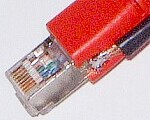|
Such a cable was proven extremely successful while connecting a laptop to a system whose ground noise exceeded 70V peak. 10/100BaseT LANs are, generally speaking, immune to noise as the signals are balanced on each 100Ω pair. The fact the signals are balanced, the common mode rejection is fairly high and the interfaces can comfortably operate with a few volts present between the two equipment grounds on either side of the LAN. In fact, some laptops are not grounded at all yet operate comfortably on Local Area Networks. Then comes practice! There is one aspect not known of LANs, they become very susceptible to noise that exceeds the common mode range of the receiver. Furthermore, even if there is no physical connection between the LAN cable and interface electronics (there is usually an isolation transformer between the interface electronics and the cable) there is still a rather high capacitive coupling. This can be worsened as some manufacturers capacitively couple the centre taps of the cable side windings to the equipment ground, usually with a 100nF or so. If the LAN is subjected to extremely high frequency spikes being introduced on the cable, or between the two grounds, it is possible the receiver AGC circuit will not be able to stay stable enough to allow successful comms. It is also possible the transmitter portions are strained by the high currents fed into them.
The answer is exceptionally simple - create a common grounding system. The best method is to use a set of crocodile clips that will allow the shield of the STP to be brought to the casing of the PC or laptop. Note: It is best to use a piece of braid between the RJ45 plug and the croc-clip as this conducts better at high frequencies than does a piece of wire (and it's more flexible). This is soldered to the casing of the RJ45 plug as shown below (it is advised to trim the casing of the cover to ensure the soldering does not hinder the plug going into the socket).
If you are constructing the cable from loose bits (you will be crimping on the RJ45 plugs yourself) then use RS code 232-9476 ferrite beads as used in our example. They are better suited to this application and offer better noise reduction as the F19 material is a better type and there are no magnetic losses from the beads being split. If you cannot obtain such cores, use anything you can lay your hands on (old PC power supplies is a good start). As a desperate measure you can wrap about 500mm of cable in a loop of 50mm diameter. This forms a common-mode choke. It's not perfect, but it's a lot better than nothing.
© 05.07.01 |
 However, all is not lost. Isn't that why Shielded Twisted Pair cable was invented? If one is running between two PCs with good quality RJ45 sockets i.e. they offer contacts that ground the shield of the STP cable, then the desired effect is obtained. But what if the one end is a laptop? What if the connection is made of pure plastic (the ever popular Xircom RealPort is such a device, and "economy" network cards often have non-STP type 'plastic only' sockets)? Then all that is achieved is a bit of shielding (if you're lucky, but no common grounding is realised).
However, all is not lost. Isn't that why Shielded Twisted Pair cable was invented? If one is running between two PCs with good quality RJ45 sockets i.e. they offer contacts that ground the shield of the STP cable, then the desired effect is obtained. But what if the one end is a laptop? What if the connection is made of pure plastic (the ever popular Xircom RealPort is such a device, and "economy" network cards often have non-STP type 'plastic only' sockets)? Then all that is achieved is a bit of shielding (if you're lucky, but no common grounding is realised). As an added measure, use clip-on EMC ferrite cores on either end of the cable. This will reduce the common-mode high frequency ground currents yet leave the signals undisturbed. Such cores are available from RS Electronics, code number 222-4343. They offer a hole for up to 6mm cable diameter. If the hole is too large and the core wants to slide around on the cable, use two cable ties to stop the core sliding.
As an added measure, use clip-on EMC ferrite cores on either end of the cable. This will reduce the common-mode high frequency ground currents yet leave the signals undisturbed. Such cores are available from RS Electronics, code number 222-4343. They offer a hole for up to 6mm cable diameter. If the hole is too large and the core wants to slide around on the cable, use two cable ties to stop the core sliding.